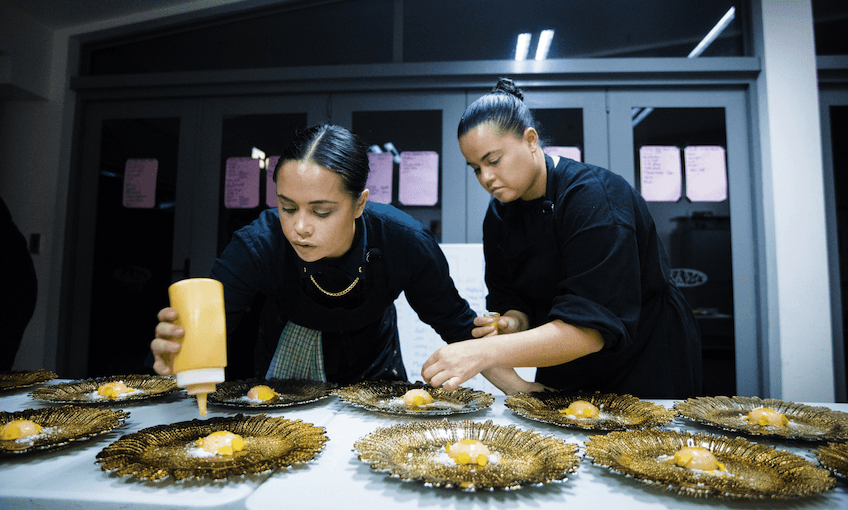Alice Neville went along to The Creation Dinner, a pop-up restaurant by MasterChef winners Karena and Kasey Bird, and it was bloody good.
Ko tēnei te tīmatatanga. This is the beginning.
In the darkness, sky father Ranginui and earth mother Papatūānuku are locked together in a never-ending embrace, their many children crushed between them. After some heated sibling-on-sibling quarrelling, the kids — understandably in need of some space — tear their poor parents apart, creating te ao marama, the natural world, in the process.
You have to admit, the creation story of Aotearoa is pretty wild. Maybe not as wild as the story of Māui’s death by toothed vagina, but wild nonetheless. (I recommend looking up the latter if you’re not familiar with it.) So if anyone wants to base a multi-sensory seven-course dinner at a mystery location around the creation story, I am a hundred per cent on board. (Maybe spare me a culinary take on Hine-nui-te-Pō’s dangerous downstairs, thanks all the same.)
Karena and Kasey Bird (Te Arawa, Ngāpuhi, Ngāti Manawa), two sisters from the small Bay of Plenty town of Maketu who won MasterChef New Zealand in 2014, did just that with The Creation Dinner, the Auckland leg of which took place over the weekend.
During the filming of the MasterChef series in question I was working with one of the judges, the notoriously hard-to-please Ray McVinnie, and he loved the Bird sisters. “These girls can cook,” I recall him saying. This is high praise from — and I mean this as a compliment — the most cynical man in food media.
Not everyone was as pumped about the Bird sisters’ creation dinner, however. Stuff ran a story about the cost to attend — an admittedly steep $320 a head for seven courses with wine pairings — and, predictably, the comments section ran hot with horror and ridicule.
“To charge this is crazy and I’ve never heard of these two and by the sound of it they are cooks not chefs so should charge accordingly,” said the comma-averse Kiwisareace.
“Seriously who are they? Dont have time for tv but to me seems like going to an idol winners concert opposed to the real thing,” added mac taggart.
Full disclosure — I did not pay $320, or even $3.20. I was hosted at the final Auckland night of the dinner, which was for media and important people, before it heads to Wellington for a couple of nights in early August.
Would I have paid $320? If I was feeling flush, and it was a special occasion, absolutely.
On a chilly Auckland evening, we met at a bar in downtown Auckland for a glass of bubbles, before the third sister of the Bird clan, the charming (and babin’) Michaela, shepherded us on to a very plush coach to head to an unknown location. Would we be going to Maketu? Would the bus transform into a mystical flying waka and take us back to Hawaiki? The possibilities were endless, but it turned out to be a brief trip on the motorway to Te Mahurehure Marae in Point Chevalier.
Inside the marae we entered a narrow, dark room, one end of which was covered in twinkly lights like the night sky. A long table — adorned with candles and blue light boxes representing the sisters’ awa — ran along the centre. Let me tell you, it was moody and atmospheric AF.
Extremely well-trained waitstaff, all young Māori women, furnished us with wine and the most delicious rēwena bread made by Karena and Kasey’s mum, Atarangi. “As you can see, we have quite a particular hiring system,” noted Karena.
The haunting sound of a taonga pūoro was our signal to shut up, as projections appeared on the roof and the dulcet tones of te reo broadcaster Scotty Morrison (who was at the dinner with his wife Stacey, on her birthday) echoed from speakers.
Te kore, the darkness, was the first part of the story, and after we’d heard Scotty’s evocative narrative, the wait-wāhine brought out dish number one. Echoing the darkness were two oysters on a bed of stone, one raw with black garlic, black vinegar and soy, the second coated in a charcoal tempura batter and paired with a creamed pāua sauce. Delicious.
Next we heard about Rangi and Papa and the extreme PDA that was pissing off their children. The dish representing this was Wakanui beef tartare with truffle “air” and rēwena crisp, the air an intensely flavoured foam that echoed the clouds of the sky father, the rēwena crisp mimicking the earth mother.
Trouble was brewing between the embracing lovers, however, as their scheming, self-centred tamariki wanted a better life. Pūpū ake was the dish representing this, a pork and watercress consommé in which floated a single diamond shell clam. My table mate, Spinoff Ātea editor Leonie Hayden, said it tasted like a next-level boil-up. (I had a pescatarian version, which was an umami bomb of deliciousness.)
Following the scheming, Tūmatauenga was the first to take action, we heard. He gathered all his god-of-war rage to push and push but ultimately failed to separate his ma and pa. Tangaroa, god of the sea, had mighty waves at his disposal, sending them crashing over the couple, but their love was too strong and they clung on.
Luckily for us diners, Tangaroa sent us kōura instead of mighty waves — butter-poached Ngāti Porou crayfish and crayfish dumpling, to be precise, with chilli and red vinegar representing the rage of old mate Tū.
Next up were the gods closest to my gluttonous heart, Haumia-tiketike and Rongo-mā-Tane, responsible for uncultivated and cultivated food respectively. They failed as well, but we diners most certainly did not, enjoying an excellent dish of miso-brûléed Kaipara kūmara with pūha and salsa verde.
Enter Tāne Mahuta, the high-achieving brother who everyone else in the family hates (I presume, anyway). Tāne is god of the forest and he’s bloody strong and also stubborn, so he pushed and pushed for ages and finally, he did it. He ripped apart his poor parents.
The corresponding dish was spiced lamb with wild pork belly and smoked potato (I got hāpuku and littleneck clam). The smoked potato was topped with deliciously crisp curry leaves and the whole dish was presented under a nifty smoke-filled cloche. I was too distracted by the novelty factor of the smoke-filled cloche and the amount of wine I’d consumed to remember exactly how it related to this particular part of the story, but it tasted damn good.
The separated lovers, of course, mourned for each other. The roimata (tears) of Rangi fell from the sky, while Papa’s rose from the earth as mist. Bit of a downer, but we got a little dish of tear-like sago floating in a palate-cleansing kawakawa and apple broth to cheer us up, with Papa’s mist rising from the plate that held it (I can only assume via magic, or maybe dried ice).
Tāne felt bad about breaking up his parents, so he planted flowers and shrubs over his mum’s body, because being nude as well as sad would add insult to injury. Ditto Dad, who got a sparkly new coat of stars and a moon on his chest, so Papa could always see him.
No new outfits for us, but we were more than happy with a salted chocolate terrine paired with a little fried bread doughnut, some blobs of smoked marshmallow and a few twinkles of edible silver leaf.
No story should end without a ray of hope or two, in this instance aptly provided by our friend Tama-nui-te-rā — the sun. Rā sent his rays in to cover the world and everyone lived happily ever after, including we diners, who got to enjoy a glorious golden orb of vanilla and passionfruit panna cotta with coconut meringue and mānuka honey.
After dinner, when the sisters came out to talk to the guests, I overheard Sid Sahrawat, probably New Zealand’s best chef, thanking them. “It was so exciting — that’s how food should be,” he said. Tautoko.
This story has been updated from an earlier version to remove the word myth.

